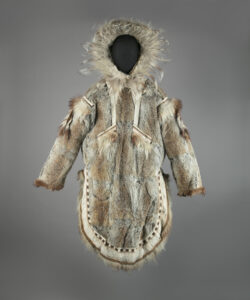“Ghhúunayúkata/To Keep Them Warm: The Alaska Native Parka” Opening May 21

Parkas are unique garments which embody the creativity, craftsmanship, and innovation of their makers. The latest exhibition from Museum of International Folk Art explores the art of the parka, a garment made for survival in the harsh environments where Alaska Native peoples live and thrive. Ghhúunayúkata/To Keep them Warm: The Alaska Native Parka is on view May 21, 2023 through April 7, 2024.
Parkas are complex expressions of Alaska Native cultures’ deep respect for the animals of land and sea. The harmonious marriage of beauty, function, and resourcefulness, parkas are a living tradition rooted in centuries of Indigenous knowledge of material science and design. At the heart of this exhibition are 20 parkas representing six Alaska Native communities: Yup’ik, Iñupiaq, Unangan, Dena’ina, St. Lawrence Island Yupik, and Koyukon. They range from historic mid-19th century to contemporary parkas illustrating the continued vitality of this art form.
“The 20 parkas selected for this exhibition represent but a small range of the magnificent variety of Native parka styles made in Alaska. They provide a representative selection of the primary furs, skins, and intestine that Alaska Native women have used for centuries in making parkas to keep their families warm and dry,” said Dr. Suzi Jones, guest co-curator of the exhibition. “The exhibition is informed by Indigenous knowledge shared during a 2019 colloquium we organized in Alaska with parka-makers and culture bearers. Their words resonate in the gallery.”
Several contemporary parkas in the exhibit challenge traditional notions of what a parka is, including a fish-skin moto-style jacket by artist Joel Isaak. These new directions in parka-making demonstrate a renewed focus on cultural revitalization, especially among a younger generation, and a willingness to hybridize traditional styles with present-day fashion.
“The parka is more than a garment. It is a symbol of Indigenous ingenuity, and its makers are at the center of this exhibition. In the exhibition, we considered parka-making through the lens of material, design, culture, and connectedness,” said Melissa Shaginoff (Ahtna/Paiute), guest co-curator. “Parka-making is an art form whose history dates back centuries, but it’s also ever-present in evolving Alaskan life and in cultural renewal efforts of Alaska Native peoples. Through incredible creativity and labor, parka-makers continue to make these remarkable garments. We see them in gatherings and celebrations, and we witness and the healing that parka-making generates for both individuals and whole communities. Parkas are both an essential garment of survival and an incredible gift of love.”
There will also be a rich selection of Indigenous drawings, photographic portraits, and traditional dolls that will provide context for how parkas are worn in ceremony, hunting, and daily use. These works underscore Native self-representation and the parka’s importance as a cultural signifier. Sewing tools, themselves beautiful works of craftsmanship in walrus ivory, wood, or animal hide, round out the exhibition content.
This exhibition is made possible through support from the Terra Foundation for American Art and is supported in part by the National Endowment for the Arts.
This press release and all others distributed by the New Mexico Department of Cultural Affairs can be found here https://media.newmexicoculture.org/releases.


Connect